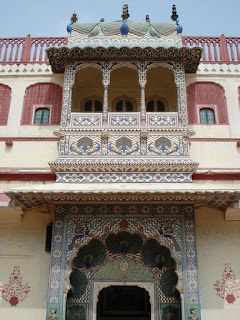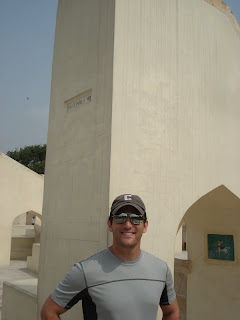We arrived in Jaipur after our visit to Fatehpur Sikri in the middle of a giant monsoon. Rain was coming down sideways and the thunder and lightning was constant. Luckily for us, we had the evening to ourselves and the sound of the storm was soothing as we rested up in our hotel room.
Luckily the next day was clear and sunny because we had a full day of sightseeing ahead of us. Our first stop: The Amber Fort / Palace. The name is kind of a misnomer as we were initially expecting alot of "amber" or at least amber colors, but the complex is built of white marble and red sandstone. The name comes from an English distortion of the original name, The Amer Palace, but the current name stuck.
The fort is known for its artistic style, blending both Hindu and Mughal elements.
 |
| The palace on the hill as we approached it. |
We were able to take an elephant ride up the hill to the palace. Truly, riding in style.
Once on top of the hill, we entered the palace courtyard.
We ascended the steps and came across the ornately decorated Ganesh gate. The gate, named after the Hindu god Ganesh, who removes all obstacles in life, is the entrance to the private palaces of the Maharajas.
Crossing through the gate we found the "Charbagh" or Paradise Garden. To the left of the garden lies the Sheesh Mahal, meaning "mirror palace", was the palace of the Maharajah and to the right is the Sukh Mahal, where the women of the royal court lived.
 |
| The Sheesh Mahal across from the Paradise Garden |
 |
| Mirror work in the Sheesh Mahal. |
 |
| Mirrored walkway of the Sheesh Mahal. |
Looking out from the terrace of the Amber Fort, we could see other large structures built on mountainsides.
Passing through to the next portion of the palace we discovered the Palace of Man Singh I, which is the oldest part of the palace fort. In the central courtyard of the palace is the pillared "baradari" or pavilion. This pavilion (which used to be curtained for privacy) was used as the meeting venue by the maharanis (queens of the royal family).
Leaving the palace we stopped to take a look at the "Jal Mahal" or Water Palace located in the middle of the Man Sagar Lake. This palace was built as a summer palace for the royal family, but is now in disrepair due to polution in the lake and general neglect, so it is impossible to actually visit the building. It does, however, look great from the shore!
Our next stop was the Hawa Mahal whose name means the "Palace of Winds" or "Palace of the Breeze". Built in 1799, it was meant to resemble the crown of the Hindu god Krishna. Its unique five-story exterior is also akin to the honeycomb of the beehive with its 953 small windows called jharokhas that are decorated with intricate lattice work. The original intention of the lattice was to allow royal ladies to observe everyday life in the street below without being seen.
Built of red and pink sandstone, the palace is situated on the main thoroughfare in the heart of Jaipur’s business center.
 |
| From the front |
 |
| Entering the palace. |
 |
| Inside the palace. |
 |
| From the top of the palace looking out onto the street below. |
We now ventured over to the nearby City Palace, which is the residence of the Maharaja's family in Jaipur, and still today functions mostly as a royal residence.
The palace was built between 1729 and 1732 and fuses Indian, Mughal, and Europoean architecture.
 |
| The entry gate to the palace. |
 |
| The Diwan-i-Khas |
The Diwan-i-Khas was the hall of private audience for the former Maharaja's but is now dedicated as a school for the study of dance for Indian girls.
Next to the Diwan-i-Khas is the Chandra Mahal, a 7 storied building that is the current residence for the descendents of the former rulers of Jaipur. The ground floor leads to the inner courtyard.
 |
| Chandra Mahal on left and Diwan-i-Khas on right. |
In the Diwan-i-Khas resides the two largest silver objects in the world (according to Guinness): water containers known as the "Gangajalis". These jars, made of 14,000 silver coins melted into sheet of silver, were built in 1894 and stand more than 5 feet tall, have a capacity of 4,000 liters and weigh more than 750 pounds. These vessels were specially made by Maharaja Sawai Madho Singh II, who was a highly pious Hindu, to carry the Ganga river water to drink on his trip to England in 1901 (for Edward VII's coronation) as he was finicky about committing religious sin by consuming the English water.
Walking through the Chandra Mahal, we arrived in the inner courtyard through the spectacular Peacock Gate.
Finally, we visited the Mubarak Mahal, meaning the "Auspicious Palace". This building in the City Palace complex was built with a fusion of the Islamic, Rajput and European architectural styles in the late 19th century as reception centre. Today it houses a museum of fine textiles.
Our final stop for the day was the Jantar Mantar (meaning "Instrument of Calculation"), a collection of architectural astronomical instruments, built between 1727 and 1734. A total of five such facilities were built at different locations, but the Jaipur observatory is the largest and best preserved.
The observatory consists of fourteen major geometric devices for measuring time, predicting eclipses, tracking stars' location as the earth orbits around the sun, ascertaining the declinations of planets, and determining the celestial altitudes and related ephemerides.
The Samrat Yantra (meaning the "supreme instrument"), the world's largest sundail, is 90 feet high, its shadow carefully plotted to tell the time of day to an accuracy of within 2 seconds.
 |
| The Samrat Yantra |
 |
| View of the instruments on the complex |
 |
| The Narivalya Yantra is a massive disc shaped sundail that also tells the time of day and has two sides for each half of the year depending on the tilt of the earth. |
Finally, we returned to the city center and found more roadway friends. Nothing better than watching the camel cart rolling by the HSBC Bank.
Obviously, we had a long and full day in Jaipur and were ready for some rest. The next day we drove back to Delhi to catch our flight out of India for Dubai.



































































